A camp for Jewish children, in the heart of the Guatemalan highlands, back in 1984; a long coffee break in Paris, as a celebration of a reunion, as loved as it was unexpected; a sordid Berlin club, run by Thai waitresses, where you can settle old scores with the past… These are the three main spaces of the novel, with their respective times, which continually alternate, in a way that is as astonishing as it is narratively effective, to build a complete and complex plot, which is read voraciously, from beginning to end.
Asteroid Books (2024). 181 Pages
Tarantula
Eduardo Halfon
We are faced with a new installment of an ongoing writing project, which began with the cycle of stories The Polish boxer (first published in 2008), and whose main integrating element is the creation of an omnipresent narrative voice: that of the character Eduardo Halfon, a portrait and fictional creation, at the same time, of the author himself.
Also on this occasion, this figure is the vertex at which the three aforementioned scenarios and times come together. Along with him, among a small cast of actors, who enter and leave as we advance in the story, two other characters stand out. The young woman Reginawhich will lead to a first and unforgettable discovery of erotic awakening in the adolescent Eduardo. And the head counselor of the camp, Samuel Blumthe main character of this work and a marked counterpoint to the vision, approach and sensitivity of the authorial narrator.
The themes that arise in this dizzying novel are related, to a large extent, to those that have appeared in other titles by the author. All of them are of deep significance. Firstly, exile, an essential condition of human existence, which is also enhanced by the specific life circumstances of Hafon, the real writer and the character. This is how the flight of that woman is mentioned Guatemala at war to settle with his family in the USA (a fact that will motivate the father’s decision to send him with his brother to that camp, during the Christmas holidays); the Jewish origin of the ancestors and the terrible experience of the grandfather (survivor of the concentration camps); the stay in Berlin –urban museum of the Holocaust–, as a result of a grant to develop a creative project that is none other than this book (a new meta-literary nod).
From this seminal nucleus, a whole series of linked questions unfold. The impossibility of assuming an inherited identity, from which it is equally impossible to escape. The conflictive parent-child relationship, which never ceases to combine a paradoxical mixture of rebellion and guilt. The strategies to escape a memory built on hate, without ceasing to feel the weight of that terrible common history of annihilation and infamy, to which an entire people, their people, was subjected… And the survival of love, despite everything.
Because it is true that, perhaps for the first time within his narrative project, this journey to childhood is marked by a dull terror that, gradually, increases in the coexistence experienced by the children of the camp. Without revealing the plot, we can say that the metaphor of the title points towards this: the reader will be able to touch the poison that engenders hatred. But, along with those passages of true thriller Psychologically, Halfon’s writing has the ability to recreate moments of profound positive emotion, always starting from small, very concrete details, which are condensers of a time of profound significance and which, for this very reason, activate memory.
Two passages are worth mentioning as examples. The first one was born from contact with a “faded and somewhat bent” photograph of the deceased father:
«Every time I see that photo it makes me want to talk to the person who was my father that night at the end of ’83, to talk to that smiling and euphoric father who was barely forty years old (ten younger than me when I wrote these lines). But I wouldn’t know what to say. Maybe we have some difficult years ahead of us, please be patient with me, it will take me a while to find my own path. Or maybe, even if I could, I wouldn’t tell him anything. So that”.
The second takes place in that reunion with Regina, so many years later, which is also a wonderful tribute to Proust: «… he brought the little white cup to his lips and I shuddered when I recognized his hand. A hand that she had completely forgotten, or thought she had completely forgotten. I recognized the shape of it. Her fingers were long and thin. The almost invisible freckles on the back of her. The roundness and pinkish tint of her nails. Without knowing it, I had kept the memory of that hand for years, within reach but well buried in some crevice of my memory, just waiting to be unearthed and dusted off the moment she lifted a little white cup of coffee.
So this whole zigzagging journey between today and yesterday, which unfolds in the novel, supposes or, rather, invites a penetrating inquiry into those vital questions that hit our deepest self. It is very likely that, once the book is closed, we will not have found a final answer. However, we will have discovered, as in its beautiful conclusion, that there is always a window open to hope and that, to open it, there is no other formula than to tell the stories, even if they hurt, and thus awaken our memory, where they nest and They all tie together.


